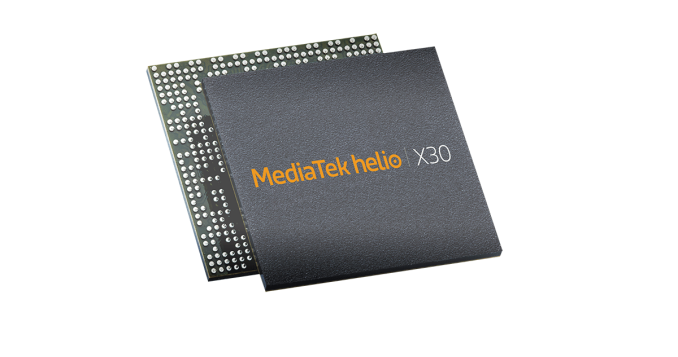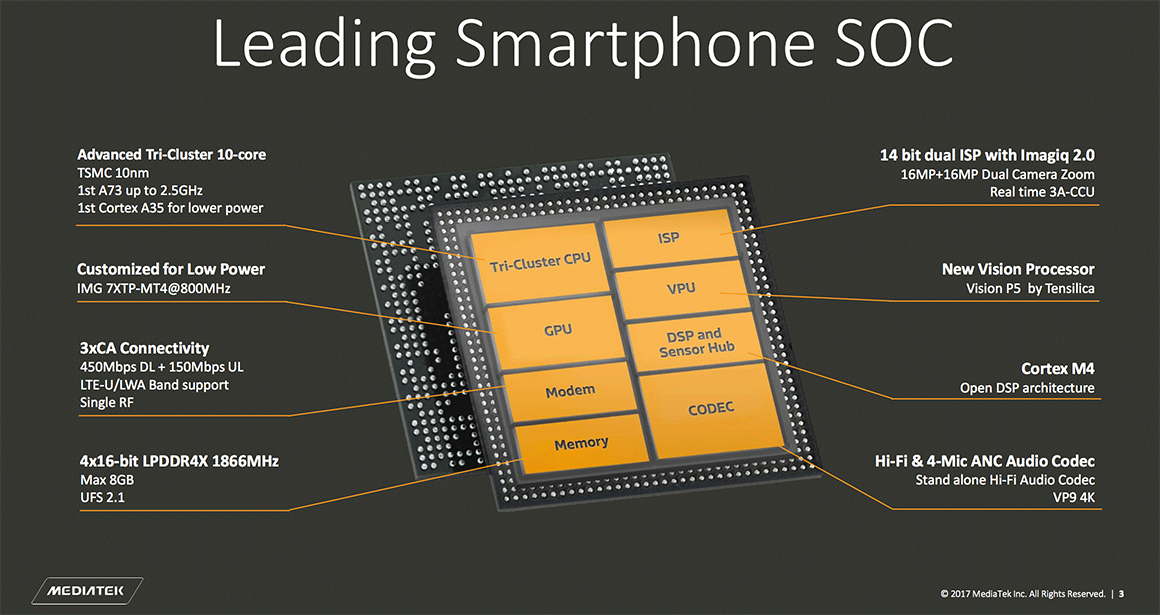MediaTek Announces Helio X30 Availability: 10 CPU Cores On 10nm
by Matt Humrick on February 27, 2017 8:35 PM EST- Posted in
- Smartphones
- Mobile
- Trade Shows
- SoCs
- MediaTek
- Helio
- MWC_2017
- Helio X30

MediaTek first unveiled the Helio X30—its next-generation high-end SoC—last fall, but today at Mobile World Congress the Taiwanese company announced its commercial availability. The Helio X30 is entering mass production and should make its debut inside a mobile device sometime in Q2 2017.
The Helio X30, like the Helio X20 family before it, incorporates 10 CPU cores arranged in a Max.Mid.Min tri-cluster configuration. Two of ARM’s latest A73 CPU cores replace the two A72s in the Max cluster, which should improve performance and reduce power consumption. The Mid cluster still uses 4 A53 cores, but they receive a 10% frequency boost relative to the top-of-the-line Helio X27. In the X30’s Min cluster we find the first implementation of ARM’s most-efficient A-series core. The A35 consumes 32% less power than the A53 it replaces (same process/frequency), while delivering 80%-100% of the performance, according to ARM. With a higher peak frequency of 1.9GHz, the X30’s A35 cores should deliver about the same or better performance than the X20’s A53 cores and still consume less power.
| MediaTek Helio X20 vs. Helio X30 | ||
| SoC | MediaTek Helio X20 |
MediaTek Helio X30 |
| CPU | 2x Cortex-A72 @2.1GHz 4x Cortex-A53 @1.85GHz 4x Cortex-A53 @1.4GHz |
2x Cortex-A73 @2.5GHz 4x Cortex-A53 @2.2GHz 4x Cortex-A35 @1.9GHz |
| GPU | ARM Mali-T880MP4 @780MHz |
PowerVR 7XTP-MT4 @800MHz |
| Memory Controller |
2x 32-bit @ 933MHz LPDDR3 14.9GB/s b/w |
4x 16-bit @ 1866MHz LPDDR4x 29.9GB/s b/w |
| Video Encode/ Decode |
encode: 2160p30 H.264 / HEVC w/HDR decode: 2160p30 10-bit H.264 / HEVC / VP9 |
encode: 2160p30 H.264 / HEVC w/HDR / VP9 decode: 2160p30 10-bit H.264 / HEVC / VP9 |
| Camera/ISP | Dual ISP 32MP @ 24fps (single camera) or 13MP + 13MP @ 30fps (dual camera) |
Dual 14-bit ISP 28MP @ 30fps (single camera) or 16MP + 16MP (dual camera) |
| Integrated Modem |
LTE Category 6 DL = 300Mbps 2x20MHz CA, 64-QAM UL = 50Mbps 1x20MHz CA, 16-QAM FDD-LTE / TD-LTE / TD-SCDMA / WCDMA / CDMA / GSM |
LTE Category 10 DL = 450Mbps 3x20MHz CA, 64-QAM UL = 150Mbps 2x20MHz CA, 64-QAM FDD-LTE / TD-LTE / TD-SCDMA / WCDMA / CDMA / GSM |
| Mfc. Process | TSMC 20SoC (planar) | TSMC 10nm FinFET |
The Helio X30 will also be the first SoC to use TSMC’s 10nm process, which will offer significant power savings relative to TSMC’s 20nm planar process that the Helio X20 family uses. According to MediaTek, the X30 consumes 50% less power than the X20 when running an unspecified CPU workload and 60% less power when running GFXBench T-Rex. These power savings will increase battery life and improve sustained performance with less thermal throttling.
Alongside the Helio X30, MediaTek is launching CorePilot 4.0, which manages CPU frequency and task scheduling. Optimized for its unique tri-cluster CPU configuration, CorePilot keeps track of the SoC’s power budget by monitoring temperature, and the global task scheduler component is responsible for migrating tasks between clusters based on workload and user experience parameters, such as frames per second. It also adjusts CPU frequency using Fast DVFS technology that increases sampling rate, allowing for faster voltage/frequency adjustments that better follow changes in workload. The overall goal of CorePilot 4.0 is to achieve the best possible performance at the lowest power levels.
In a short presentation at its MWC booth Monday, Executive Vice President & Co-COO Jeffrey Ju stated that MediaTek expects only a limited number of phones to use the Helio X30, perhaps less than ten. He also mentioned that a low yield rate for TSMC’s 10nm process has delayed the X30’s availability. The X30 sounds compelling on paper, so it will be interesting to see how many design wins it can actually achieve.











57 Comments
View All Comments
vladx - Tuesday, February 28, 2017 - link
Meizu MX7 is rumoured to be using Kirin 960, not Mediatek.jjj - Thursday, March 2, 2017 - link
That's utter nonsense, as most so called rumors from CHina it's from a random guy on Weibo.It's highly likely they use Mediatek and a 10% chance they use Samsung but Samsung is likely supply limited on 10nm as even the S8 had to be delayed because of it.
WPX00 - Tuesday, February 28, 2017 - link
I'm actually almost certain the CPU config has been entirely redone from the first announced design. Corrsct me if im wrong but i believe the original config was 4x A73, 6x A53.Meteor2 - Tuesday, March 14, 2017 - link
Yep! Completely different.pberger - Monday, February 27, 2017 - link
Are any of you aware of who is first at integrating a neuromorphic chip in a SOC for better rendition/development of deep learning neural networks over a smartphone?jjj - Monday, February 27, 2017 - link
Nobody as there isn't really anything like that beyond early R&D.Doing it on GPU/DSP/VPU is what we'll see for now.
Meteor2 - Tuesday, February 28, 2017 - link
Pretty sure the Snapdragon 835 has something like that.name99 - Tuesday, February 28, 2017 - link
It's the kind of question that's vague enough that everyone can give whatever answer they want.QC can say they have such a great library that uses Adreno and Hexagon that you get all the advantages of neuromorphic today. Apple can say they tweaked their customization of PowerVR to be optmized for neuro. And they could all even kinda be true.
Or going the other direction, Apple could announce that the A11 has the N11 neuromorphic computing unit on board, and what does that mean? There are already custom neuro routines in the iOS APIs (part of the Accelerate library) so ANY hardware that's even slightly optimized as a target for those routines (even just something like a specialized cache added to the GPU) could be called the N11 neuromorphic processor and be kinda sorta technically accurate.
On the other hand, this is not exactly a tragedy. On the TECHNICAL side, everyone knows the value of neuro, so we are getting there one improvement at a time across all vendors. And on the marketing side, who cares? The same crowd that say "Siri sux and Google image recognition is best" will fight it out with the crowd that says "Alexa is best and MS doesn't have a clue about image recognition" and details about who is using what hardware won't change any minds...
Mavendependency - Tuesday, February 28, 2017 - link
Last year's 8890 also does.saratoga4 - Wednesday, March 8, 2017 - link
>Pretty sure the Snapdragon 835 has something like that.It has a DSP core, which is basically the opposite of a neuromorphic coprocessor :)
Probably be a very long time, if ever, before you see things like that on a mobile device. You'll probably just see more DSPs/GPUs with libraries to support linear algebra for NNs.